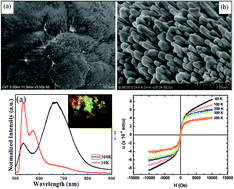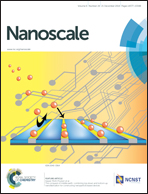Anomalous optical and magnetic behavior of multi-phase Mn doped Zn2SiO4 nanowires: a new class of dilute magnetic semiconductors
Abstract
We present the synthesis of Mn doped Zn2SiO4 dense nanowire bundles using the VLS mode of growth with unusual optical and magnetic properties. The synthesized Zn2SiO4 nanowires were identified with two phases, α-Zn2SiO4 as the major phase and β-Zn2SiO4 as the minor phase. XPS studies confirmed that Zn2SiO4 nanowires were Zn rich and Mn doped. Temperature dependent photoluminescence (PL) measurements showed three distinct emission bands: green, yellow and red due to Mn doping in the α-phase, β-phase and the substitution of Si with Mn in the α-phase, respectively. The PL analysis showed that these emission bands followed anomalous Berthelot-type behavior. The carrier escape energies were 70 ± 3 meV, 49 ± 2 meV and 65 ± 4 meV for the 530, 570 and 660 nm bands, respectively, while the radiation rates (Er =) were 1.0 ± 0.4 meV, 3.10 ± 1.10 meV and 1.4 ± 0.4 meV corresponding to the three respective bands. Mn doping of Zn2SiO4 nanowires induced ferromagnetism, which was observed above room temperature, with a Curie temperature well above 380 K. The observation of magnetic behavior in this class of semiconductors has potential applications in high temperature spintronics and magneto-optical devices.


 Please wait while we load your content...
Please wait while we load your content...